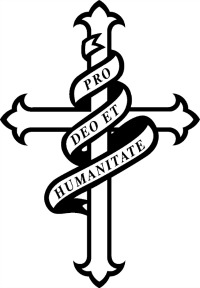 Mater's brand journey
Mater's brand journey
Mater's original brand was represented in the form of a cross that was created in South East Queensland in 1906. It is believed that the Sisters of Mercy developed a symbol to represent their new brand that embodied their heritage, religion, culture and medical business. One of the Sisters, Sr M Antonia Brosnan who was in charge of the operating theatres, had artistic talents and is thought to have created the Mater Cross. It was first used publicly on a flag in 1908 to mark the laying of the foundation stone for Mater Private Hospital on Mater Hill.
Since then, the Mater Cross has taken on different forms across Queensland and remained an important feature of Mater's logo and a symbol of hope to those in need. In 2018, the cross transitioned into a new symbol to reflect the organisation's new strategic direction which repositions Mater as a group that incorporates health, education and research for a healthy community.
To learn more about the history of the Mater logo in South East Queensland, please read the following historical account by Sr Regis M. Dunne rsm.
Historical account of the Mater Cross in South East Queensland
When Mother Vincent Whitty travelled from Ireland to Queensland in 1861, to carry on the work of the Foundress of the Sisters of Mercy, Catherine McAuley, she carried with her the heritage of the Sisters of Mercy, their desire to serve God, through serving the needy. In the new country this found expression first through education, and for their first forty years in Queensland, the Sisters of Mercy concentrated on establishing schools. Mother Vincent, a teacher herself, had great concern for the sick, and had been responsible for the planning and building of the first Mater Hospital in Dublin, and until her death in 1892, she dreamed of establishing a Mater Hospital in Brisbane.
When her dream became a reality in 1906, and planning began for the building in South Brisbane, excitement grew before the ceremony to mark the turning of the first sod, and then again before the laying of the foundation stone on the 24th May, 1908. During this time, several Sisters of Mercy were nursing at “Aubigny” the first Mater Hospital, established in rented premises at North Quay, and they gave considerable thought to a symbol, which would represent the meaning of the new enterprise, especially its heritage, in cultural, religious and medical dimensions.
One of the young Sisters was Sr. M. Antonia Brosnan. She was an Irish girl, who, with her brother, had migrated to Australia and had trained as a Nurse at the Royal Brisbane Hospital, and then had worked as a charge nurse there, before joining the Sisters of Mercy. At “Aubigny” she was in charge of the operating theatre, and later became the first Matron of the new Mater Private Hospital. Sr. M. Antonia had artistic talent, and it is thought that she was the one, who, in 1906, created the Mater Cross, which was first used publicly, resplendent on a flag of blue and white, to mark the laying of the foundation stone of the first Brisbane Mater Private Hospital, in 1908. Four years later, it appeared in print, as a logo on the front of the printed Annual Report of the first Mater Board. It had become the Mater Badge.
Symbolism of the Mater Cross
For God and Humanity. This motto underpins the philosophy of the Sisters of Mercy and the Mission of the Mater Hospitals. Latin is used, because, at the time Latin was widely used in Medicine. Pro Deo et Humanitate, the Latin version, maintains the link with the Medical Profession, as does its printing on the scroll around the Cross, which is reminiscent of the medical Caduseus, itself of Biblical origin. This is a constant reminder of the history and the future of the Mater Hospital. The colours blue and white symbolise hope and fidelity to the living of the motto. The origins of the Mater Cross are steeped in the beginnings of the Order of Mercy. The Mater Cross is derived from the Celtic Cross, which is featured on the crest of the Order of Mercy. The modified Celtic Cross emphasises the Irish origin of the Mercy Institute.
The Mater Badge has, for a century now, been the much loved emblem of the Mater Nurses. Sr. M. Antonia, the first Matron of the original Mater Private Hospital, would scarcely have contemplated the inspiration her art work would be. Sadly she died suddenly in 1912, while undergoing surgery herself in the new hospital. Her medical friends subscribed to a permanent memorial to her, a marble bust of the Foundress of the Sisters of Mercy, Mother Catherine McAuley. This can still be seen, enshrined in the vestibule of Sr. M. Antonia’s first Mater Private Hospital, now known to us as Aubigny Place.
All these links to people, history, human experience and continuance, give us hope and a sense of privilege in our own contributions.
Sr. Regis M. Dunne R.S.M.